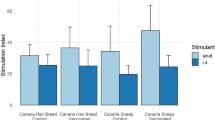Summary
Protective immunity to the larval stages of the nematode, Amplicaecum robertsi was studied in laboratory rodents. A significant (P<0.05) degree of protection was conferred passively to mice by the serum globulins from rats previously infected with eggs of this nematode. Mice vaccinated with excretory-secretory products of 3rd stage larvae collected in vitro were somewhat protected when challenged with A. robertsi eggs but the results were not statistically significant (P>0.05).
Similar content being viewed by others
References
Campbell, C. H.: The antigenic role of excretions and secretions of Trichinella spiralis in the production of immunity in mice. J. Parasit. 41, 483–491 (1955).
Chandler, A. C.: Further experiments on passive immunity of rats to Nippostrongylus infections. Amer. J. Hyg. 28, 51–62 (1938).
Chipman, P. B.: Antigenic role excretions and secretions of adult Trichinella spiralis in the production of immunity in mice. J. Parasit. 43, 593–598 (1957).
Chute, R. M.: The dual antibody response to experimental trichinosis. Proc. helminth. Soc. Wash. 23, 49–58 (1956).
Culbertson, J. T.: Passive transfer of immunity to Trichinella spiralis in the rat. J. Parasit. 28, 203–206 (1942).
Dobson, C.: The relationship between worm population density, host survival and the growth of the third-stage larva of Amplicaecum robertsi Sprent and Mines, 1960, in the mouse. Parasitology 55, 183–193 (1965a).
Dobson, C.: The effects of host sex and age on the host-parasite relationship of the third-stage larva of Amplicaecum robertsi Sprent and Mines, 1960, in the laboratory rat. Parasitology 55, 303–311 (1965 b).
Dobson, C.: The immunoglobulin response of rats to Amplicaecum robertsi infestations. Aust. J. exp. Biol. med. Sci. 46, 319–325 (1968 a).
Dobson, C.: Hematological changes induced in laboratory rats by larval Amplicaecum robertsi Sprent and Mines. Aust. J. biol. Sci. 21, 341–350 (1968 b).
Guerrero, J., Silverman, P. H.: Ascaris suum: Immune reactions in mice. II. Metabolic and somatic antigens from in vitro cultured larvae. Exp. Parasit. 29, 110–115 (1971).
Hogarth-Scott, R. S.: The immunology of nematode antigens, including the serodiagnosis of human visceral larva migrans. Ph. D. thesis, University of Cambridge, England, 1966.
Jones, V. E., Edwards, A. J., Ogilvie, B. M.: The circulatory immunoglobulins involved in protective immunity to the intestinal stage of Nippostrongylus brasiliensis in the rat. Immunology 18, 621–633 (1970).
Oliver-Gonzalez, J.: The dual antibody basis of acquired immunity in trichinosis. J. infect. Dis. 69, 254–270 (1941).
Onkelinx, E., Menldermans, W., Joniau, M., Lontie, R.: Glutaraldehyde as a coupling reagent in passive hemagglutination. Immunology 16, 35–43 (1969).
Sadun, E. H.: The antibody basis for immunity in chickens to the nematode Ascaridia galli. Amer. J. Hyg. 49, 101–116 (1949).
Sarles, M. P.: Protective and curative action of immune serum against Nippostrongylus muris in the rat. J. infect. Dis. 65, 183–195 (1939).
Sinclair, I. J.: The relationship between circulating antibodies and immunity to helminth infections. Advanc. Parasit. 8, 97–138 (1970).
Soulsby, E. J. L.: Some immunological phenomena in parasitic infections. Vet. Rec. 69, 1129–1139 (1957).
Soulsby, E. J. L.: The nature and origin of functional antigens in helminth infections. Ann. N.Y. Acad. Sci. 113, 492–509 (1963).
Sprent, J. F. A.: The life history and development of Amplicaecum robertsi, an ascaridoid nematode of the carpet python (Morelia spilotes variegatus). I. Morphology and functional significance of larval stages. Parasitology 53, 7–38 (1963).
Thorson, R. E.: Studies on the mechanism of immunity in the rat to the nematode Nippostrongylus muris. Amer. J. Hyg. 58, 1–15 (1953).
Thorson, R. E.: Absorption of protective antibodies from serum of rats immune to the nematode Nippostrongylus muris. J. Parasit. 40, 300–303 (1954).
Wilson, R. M.: γ1-antibodies in guinea pigs infected with the cattle lungworm. Immunology 111, 199–209 (1966).
Author information
Authors and Affiliations
Additional information
Present address: Department of Community and Preventive Medicine, Stanford University School of Medicine, Stanford, California, U.S.A. 94305. Supported by USPHS Postdoctoral Fellowship Number 1-F2-AI-36,421-01.
Rights and permissions
About this article
Cite this article
Diconza, J.J. A study of protective immunity to Amplicaecum robertsi (nematoda) in rats and mice. Z. Parasitenk. 41, 65–71 (1973). https://doi.org/10.1007/BF00329631
Received:
Issue Date:
DOI: https://doi.org/10.1007/BF00329631




